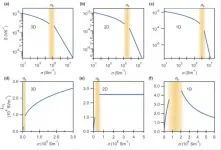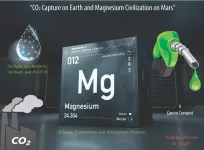Better metric for thermoelectric materials means better design strategies
New quantity helps experimentally classify dimensionality of thermoelectric materials
2021-04-10
(Press-News.org) Tokyo, Japan - Researchers from Tokyo Metropolitan University have shown that a quantity known as "thermoelectric conductivity" is an effective measure for the dimensionality of newly developed thermoelectric nanomaterials. Studying films of semiconducting single-walled carbon nanotubes and atomically thin sheets of molybdenum sulfide and graphene, they found clear distinctions in how this number varies with conductivity, in agreement with theoretical predictions in 1D and 2D materials. Such a metric promises better design strategies for thermoelectric materials.
Thermoelectric devices take differences in temperature between different materials and generate electrical energy. The simplest example is two strips of different metals welded together at both ends to form a loop; heating one of the junctions while keeping the other cool creates an electrical current. This is called the Seebeck effect. Its potential applications promise effective usage of the tremendous amount of power that is wasted as dissipated heat in everyday life, whether it be in power transmission, industrial exhaust, or even body heat. In 1993, it was theorized that atomically thin, one-dimensional materials would have the ideal mix of properties required to create efficient thermoelectric devices. The resulting search led to nanomaterials such as semiconducting single-walled carbon nanotubes (SWCNTs) being applied.
However, there was an ongoing issue that prevented new designs and systems from being accurately characterized. The key properties of thermoelectric devices are thermal conductivity, electrical conductivity, and the Seebeck coefficient, a measure of how much voltage is created at the interface between different materials for a given temperature difference. As material science advanced into the age of nanotechnology, these numbers weren't enough to express a key property of the new nanomaterials that were being created: the "dimensionality" of the material, or how 1D, 2D or 3D-like the material behaves. Without a reliable, unambiguous metric, it becomes difficult to discuss, let alone optimize new materials, particularly how the dimensionality of their structure leads to enhanced thermoelectric performance.
To tackle this dilemma, a team led by Professor Kazuhiro Yanagi of Tokyo Metropolitan University set out to explore a new parameter recently flagged by theoretical studies, the "thermoelectric conductivity." Unlike the Seebeck coefficient, the team's theoretical calculations confirmed that this value varied differently with increased conductivity for 1D, 2D and 3D systems. They also confirmed this experimentally, preparing thin films of single-walled carbon nanotubes as well as atomically thin sheets of molybdenum sulfide and graphene, archetypal materials in 1D and 2D respectively. Measurements conclusively showed that the thermoelectric conductivity of the 1D material decreased at higher values of conductivity, while the curve for 2D materials plateaued. They also note that this demonstrates how the dimensionality of the material is retained even when the material is prepared in macroscopic films, a great boost for efforts to leverage the specific dimensionality of certain structures to improve thermoelectric performance.
Combined with theoretical calculations, the team conclude that high thermoelectric conductivity, high conventional electrical conductivity, and low thermal conductivity are key goals for the engineering of new devices. They hope these measurable, tangible targets will bring much needed clarity and unity to the development of state-of-the-art thermoelectric devices.
INFORMATION:
This work was supported by JSPS KAKENHI Grants-in-Aid for Scientific Research (17H06124, 17H01069, 18H01816, 19J21142, 20H02573, 20K15117, 26102012, 25000003, 19K22127, 19K15383, 20H05189) and the JST CREST Program (MJCR17I5).
[Attachments] See images for this press release:

ELSE PRESS RELEASES FROM THIS DATE:
2021-04-10
From power grids and telecommunications to water supply and financial systems, digital data controls the infrastructure systems on which society relies. These complex, multi-tier systems depend on layered communications to accomplish their tasks - yet every point of contact becomes a potential target, every path of information a potential weak spot for malicious actors to attack.
A team of researchers from the University of Calabria in Italy has developed the first predictive control scheme that can help distributed networks with multiple agents not only identify these ...
2021-04-09
Active surveillance leads to improved quality of life
Men with low health literacy seven times less likely to accept active surveillance
Prostate cancer and active surveillance patient education is needed
Tumor gene profiling is a tool that can help patients with a cancer diagnosis make informed decisions about treatment. In predominantly white populations, among men with early stage, favorable-risk prostate cancer, these tools have been shown to increase patient acceptance of active surveillance -- a common, evidence-based approach to monitor the tumor before a more aggressive treatment, like surgery or radiation.
However, ...
2021-04-09
A new study finds older adults who received positive airway pressure therapy prescribed for obstructive sleep apnea may be less likely to develop Alzheimer's disease and other kinds of dementia.
Researchers from Michigan Medicine's Sleep Disorders Centers analyzed Medicare claims of more than 50,000 Medicare beneficiaries ages 65 and older who had been diagnosed with OSA. In this nationally representative study, they examined if those people who used positive airway pressure therapy were less likely to receive a new diagnosis of dementia or mild cognitive impairment over the next 3 years, compared to people who did ...
2021-04-09
Auroral displays continue to intrigue scientists, whether the bright lights shine over Earth or over another planet. The lights hold clues to the makeup of a planet's magnetic field and how that field operates.
New research about Jupiter proves that point -- and adds to the intrigue.
Peter Delamere, a professor of space physics at the University of Alaska Fairbanks Geophysical Institute, is among an international team of 13 researchers who have made a key discovery related to the aurora of our solar system's largest planet.
The team's work was published April 9, 2021, in the journal Science Advances. The research paper, titled "How Jupiter's unusual magnetospheric topology structures its aurora," was written by Binzheng ...
2021-04-09
For the first time, researchers have been able to obtain data from underneath Thwaites Glacier, also known as the "Doomsday Glacier". They find that the supply of warm water to the glacier is larger than previously thought, triggering concerns of faster melting and accelerating ice flow.
With the help of the uncrewed submarine Ran that made its way under Thwaites glacier front, the researchers have made a number of new discoveries. Professor Karen Heywood of the University of East Anglia commented:
"This was Ran's first venture to polar regions and her exploration of the waters under the ice shelf was much more successful than we had dared to hope. We plan to build on these exciting findings ...
2021-04-09
Tick-borne encephalitis is a disease just as nasty as it sounds. Once bitten by an infected tick, some people develop flu-like symptoms that resolve quietly but leave behind rampant neurological disease--brain swelling, memory loss, and cognitive decline. Cases are on the rise in Central Europe and Russia with some 10,000 incidents reported each year. Vaccines can provide protection, but only for a limited time. There is no cure.
Now a new study describes antibodies capable of neutralizing the virus transmitted by tick bites. These so-called broadly neutralizing antibodies have shown promise in preventing TBE in mice and could inform the development of better vaccines for humans. ...
2021-04-09
Children may not be as infectious in spreading SARS-CoV-2 to others as previously thought, according to new University of Manitoba-led research in CMAJ (Canadian Medical Association Journal).
"Our findings have important public health and clinical implications," writes principal investigator Dr. Jared Bullard, associate professor, pediatrics/child health and medical microbiology/infectious diseases, Max Rady College of Medicine, University of Manitoba and associate medical director, Cadham Provincial Laboratory in Winnipeg, Manitoba. "If younger children are less capable of transmitting infectious virus, daycare, in-person school and cautious extracurricular activities may be safe to continue, with appropriate precautions in place, ...
2021-04-09
When setting SARS-CoV-2 vaccine priorities, Canada should take a more nuanced approach that considers geographic and occupational risk exposures, as 75% of Canadian adults have at least 1 risk factor for severe COVID-19, argues an analysis in CMAJ (Canadian Medical Association Journal).
"Using risk factors for severe COVID-19 in a strategic vaccination strategy may not offer much refinement because of how widespread these conditions are. More detailed weighting of medical, geographic and occupational risks might be required if vaccination is constrained," writes Dr. Finlay McAlister, Faculty of Medicine & Dentistry, University of Alberta, Edmonton, Alberta, with coauthors. "In particular, since the third wave of the COVID-19 pandemic appears ...
2021-04-09
Excessive CO2 emissions are a major cause of climate change, and hence reducing the CO2 levels in the Earth's atmosphere is key to limit adverse environmental effects. Rather than just capture and store CO2, it would be desirable to use it as carbon feedstock for fuel production to achieve the target of "net-zero-emissions energy systems". The capture and conversion of CO2 (from fuel gas or directly from the air) to methane and methanol simply using water as a hydrogen source under ambient conditions would provide an optimal solution to reduce excessive CO2 ...
2021-04-09
BOSTON -- Videos of people experiencing severe neurological symptoms, including convulsions and difficulty walking, purportedly after receiving a COVID-19 vaccine, have surfaced on Facebook, YouTube and other social media channels. The millions of people watching these videos might conclude that the vaccine is either quite dangerous to produce such symptoms or that the people in the videos are faking their symptoms. Both conclusions are incorrect, according to neurologist and psychiatrist David Perez, MD, MMSc, director of the Functional Neurological Disorders Unit at Massachusetts General Hospital (MGH).
In a JAMA Neurology Viewpoint, the authors explain that the COVID-19 vaccine may precipitate the development of functional neurological disorder (FND), a neuropsychiatric disorder with ...
LAST 30 PRESS RELEASES:
[Press-News.org] Better metric for thermoelectric materials means better design strategies
New quantity helps experimentally classify dimensionality of thermoelectric materials




